CRAWFORD COUNTY - About 25 Crawford County farmers, conservation professionals, legislative representatives and interested citizens gathered in Prairie du Chien on Thursday, Feb. 27 for a ‘Water, Soil, Nutrients and Farming’ presentation. Amber Radatz, Director of UW-Extension Discovery Farms, made a presentation, and then moderated a farmer panel discussion.
Radatz has been with Discovery Farms since 2004, and served as executive director since 2013. Discovery Farms conducts on-farm research about the relationship between different land treatments and farming systems, and the quantity and quality of runoff. Her research has developed a dataset compiled from research on 22 farms, at 55 sites, encompassing 151 surface runoff site years.
Discovery Farm’s research is focused on runoff, but not on leaching of nutrients through the soil profile into groundwater.
“We are hoping to find ways to partner with those already studying nitrogen leaching to grow the body of research in Wisconsin on these topics,” according to Radatz.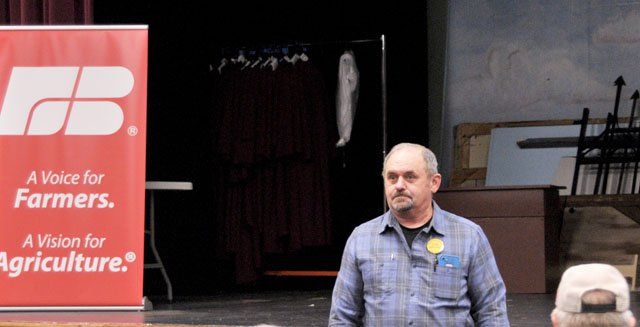

Don Brown, President of Crawford County Farm Bureau, made introductory remarks.
“This is the time of water, and farmers want to be part of the discussion,” Brown said. “The question is about how we get there. Tonight, our purpose is to address farming and the public’s misconceptions about it.”
Background in dairy
Radatz began by discussing growing up on a dairy farm in Trempealeau County, and eventual selection of a major in college.
“Life on a small dairy farm is not always sunshine and roses,” Radatz said. “As a high school student, having to do chores and help with the farm work meant that there were lots of things I wanted to do that I couldn’t.”
This experience led Radatz to believe that farming would not be the career for her. In college, she reports, she bounced through a few different agriculture degrees before settling on soil science.
“There was no anatomy to memorize and no cows to milk,” Radatz said. “Studying soil science helped to make the world make sense to me.”
She told the crowd that having grown up on a dairy farm in Trempealeau County means that she is keenly aware of the particular challenges farmers face in the Driftless Region. Pointing to a map of soils in Crawford County, Radatz emphasized that farmers in this area have to deal with a very complicated hydrogeology and steep terrains.
“Our mission at Discovery Farms is to help farmers engage in continuous improvement and to better understand the risks of different practices,” Radatz explained. “For farmers, deciding which tools to adopt will be their license for continuing to be able to farm in the future.”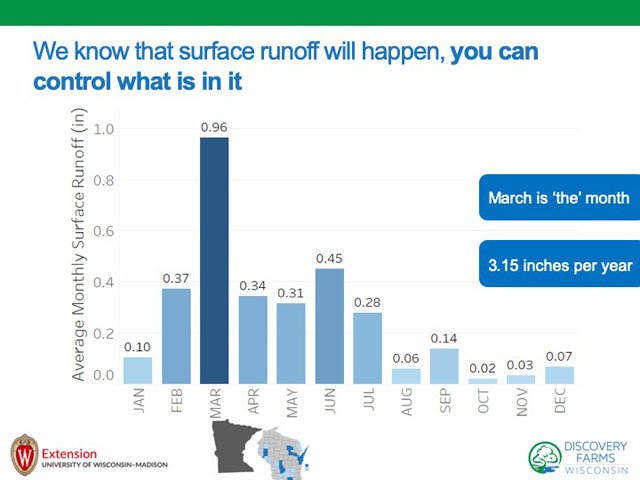

Runoff will happen
Radatz emphasized that in all of Discovery Farm’s research, there had only ever been one field monitored that had produced no runoff in a year. That field was a pasture on sandy soils. Her message is “runoff will happen,” and she said this is especially true in the steep hilly areas in the Driftless.
“We know that runoff is going to happen, and we know when the risk is the highest,” Radatz said. “What this means is that farmers do have the information they need to reduce their risk and exert control over what is in the runoff that happens at the higher risk times of year.”
Pointing to a chart which showed the amount of runoff that typically happens in each month of the year, Radatz pointed out that the highest volume of runoff occurs in the month of March.
“But, while there might be a lot of water moving in March, really, the risk is elevated in February through July,” Radatz said. “In February and March, the risk is snowmelt on top of frozen soils; in April and May, the risk comes from frequent precipitation events on top of saturated soils; and in June and July, the risk is storm-driven, with large rainfall events that can be falling on saturated soils as well.”
Overall, Radatz said that her research shows that of the average 32 inches per year of rain that falls in our area, about 3.15 inches (about 10 percent) becomes runoff. She emphasized that soil is at the greatest risk of moving in the spring, before the crops are planted. As Kevin Masarik of the UW-Stevens Point Center for Watershed Science and Education points out, in most agricultural fields there are plant roots in the soil for only 140 out of the 365 days in a year.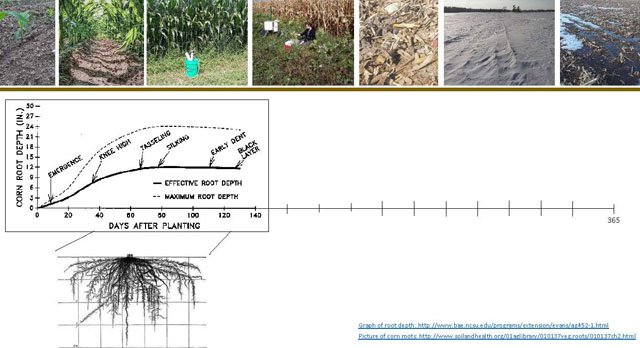

“In May, June and July is when 76 percent of soil loss occurs, and the reason for this is a combination of vulnerable fields and intense storm events,” Radatz said. “The best way to prevent this runoff is to armor your soils with living roots, and the level of protection needed will be very site specific.”
No silver bullet
Radatz explained that there has been a lot of research done on the runoff risk from tilled versus no-till fields. Radatz took a balanced position, saying that tillage does not necessarily mean there will be an instant soil loss disaster, but on the other hand, using a no-till system does not mean that there will be no runoff of phosphorous.
Radatz said that from Discovery Farm’s research, it has been shown that the median soil loss from a tilled field is about 193 lbs./acre per year. That is an amount about equal to a couple of wheelbarrow loads per year. The median soil loss from a no-till field is about 46 lbs./acre per year.
“No-till performs better in situations where storm rainfalls exceed the soil’s capacity to infiltrate water,” Radatz explained. “Tillage can destroy the structure of the soil and reduce its capacity to infiltrate water.”
But, Radatz emphasized that no-till alone is not “the silver bullet.” She explained the difference between the two types of phosphorous – bound and soluble. Bound phosphorous is bound to soil, and only runs off into surface water if the soil is displaced.
Soluble phosphorous lays on the surface of the soil, and is not bound. This phosphorous can be dissolved in water in rain events and can run off. This excess phosphorous can come from applications of chemical fertilizers or manure, from lawn fertilizers, from decaying plant matter or forestlands, and from septic systems.
According to Discovery Farm’s research results, it is not possible to say that one source of agricultural nutrients versus another is more likely to result in runoff.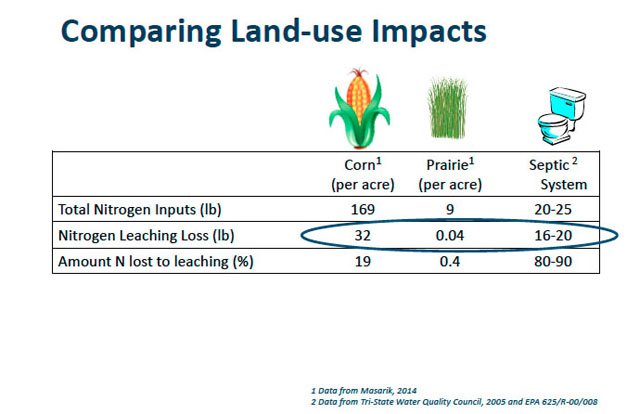

“From our dataset, nitrogen and phosphorus can be lost from both chemical fertilizers and manure,” Radatz said. “The largest determining factor of how much is lost has less to do with the source of nutrients, and more to do with the timing.
“In the hilly landscape of the Driftless, no-till is a farmer’s first step to reduce soil loss, but not the last,” Radatz said. “The next step is to carefully time application of nutrients, and to consider incorporating cover crops or small grains into your rotations. What is called for is management on a landscape basis.”
As far as a silver bullet for Crawford County farmers, Radatz emphasized that it will require a “network of conservation practices.” The network she described would include minimizing tillage, putting covers and small grains into the rotation, using contour strips and grassed waterways, and converting acres to managed grazing.
“Farmers are going to need to choose to engage in these practices,” Radatz said. “If you don’t choose to use these practices, then someone else will choose for you.”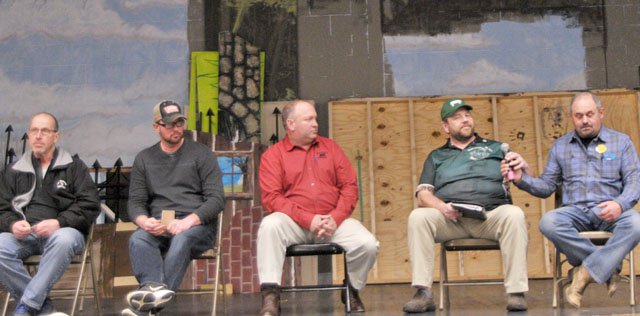

Farmer panel
After Radatz finished her presentation, she moved on to moderating a question-and-answer session with five farmers that included Steve Achenbach, Chad Sime, AV Roth and Don Brown of Crawford County, and Joe Bragger, a Buffalo County farmer and current president of the Wisconsin Farm Bureau.
Bragger’s farm was the site of the first Discover Farm monitoring project, from 2001-2008. The Braggers produce dairy, beef, poultry and crops. Their farm was selected for the research because it represented the challenges of farming in the Driftless Region of Wisconsin; with streams at the bottom of most fields, large expanses of woodland and grasses, along with row crop production on steep fields.
According to Discovery Farm’s web site, the Braggers provided Discovery Farm’s research program with a set of paired basins (ideal research basins) where common no-till farming practices could be compared to a site consisting mostly of woodland, pasture and CRP (95 percent of the basin).
The Braggers were selected as the ‘Conservation Farmers of the Year’ by the State Land and Water Conservation Board, prior to their selection as a Discovery Farm.
The farm had installed thousands of feet of grassed waterways in areas of concentrated flow, built small check dams high in the watershed to reduce storm flow and allow water to slowly seep out of the woods and into the waterways. They also practice conservation tillage (no-till) for the establishment of corn, soybeans, wheat, grasses and alfalfa.
In areas where water was entering the stream, the Braggers have buffers in place to allow sediment and nutrients to settle out to reduce nonpoint source pollution. The farm was also one of the first to develop and implement a nutrient management plan and assist in the development of the producer training program now offered in counties throughout the state.
AV Roth is the operator of the Roth Feeder Pigs, farrow-to-wean hog CAFO in Wauzeka Township in Crawford County. He has stated that he plans to pursue an expansion to develop a second facility in neighboring Marietta Township, though the county has not received a livestock facility permit application. He is a fifth generation Crawford County farmer.
Steve Achenbach milks 250 cows on a farm in rural Seneca. They also plant 400-500 acres of alfalfa and corn. The family hosted the Crawford County Dairy Breakfast in June of 2011.
Chad Sime runs a 90-cow dairy in rural Mt. Sterling, with about 300 acres in crops, including 50 acres in certified organic crops. He also runs some beef cattle on the farm.
Don Brown is the president of the Crawford County Farm Bureau, and farms in the southern part of Crawford County. He grows corn, soybeans and hay.
Question One: tell us about what agricultural practices you are excited about.
Brown:Throughout my career as a farmer, I’ve always used the practices that I thought were the best at that time, and I’m always learning new things. Our farm has gone to no-till management, and whenever possible, we grow our hay on the steeper ground and plant the corn and beans where it is flatter. We have participated for the last three year’s in the county’s cover crop program with mixed results. There were some years where the covers grew too high and interfered with harvesting the beans. In other years, wet conditions have interfered with getting the covers planted. Brown reported that one friend told him that for farmers farming north of Interstate 80, growing covers is more difficult because of the weather.
“I enjoy farming, and take pride in my work,” Brown said. “I do what I can to improve my soil health because I don’t enjoy writing a check for fertilizer, but I’m not sure if cover crops will really work for farmers this far north.”
Roth:“We’re always going to try to get better at what we do. On our farm we use no-till, and we use manure for fertility. What I really enjoy is teaching my kids to take care of the soil.”
Bragger:Bragger said that 40 years ago, when he was a kid and his family had a 50-cow dairy, he believes there was more contamination of the stream because they had their cattle lot by the stream. “I’m a big fan of cover crops, but they have to get in the ground early.” Bragger says he has been successful with planting a fall cover of rye after corn silage, and then he plants alfalfa right into the growing rye. He has also worked with rye grown over the winter, which he harvests as forage. He follows this with Sudan grass, which he harvests twice for forage, and then seeds in alfalfa in August. “What we need is continuous cover on our fields and constant learning.”
Sime:Sime said that he has learned a lot of the things he’s learned “by mistake.” He has converted some of his acres to organic production, and has also grown straight Sudan for forage, which he reports has given him “great milk production.” He spreads his manure in May, and plants Sudan grass in June from which he takes three cuttings. “Working with more rotations gives me more windows for manure application, and allows me to cut back on the inputs applied to a lot of my land – for some of my ground, I have gotten it down to just potash.”
Achenbach:Achenbach reports that the biggest challenge he has is establishing a planting of alfalfa, and has had some success with using oats as a nurse crop. “I don’t use any commercial fertilizers on my land – I get my nitrogen from alfalfa.”
Question Two: How has your understanding of agriculture’s role in protecting water quality evolved over time?
Achenbach:“My biggest eye opener was when I got my first nutrient management plan and learned that I didn’t need any fertilizer on my land,” Achenbach said. “I also heard about those brown water events over in Kewaunee County – that’s crazy, we can’t have brown water coming out of people’s taps.”
Sime:Sime joked, “I’m younger so I still have more time to evolve.” He talked about his agricultural education at UW-Platteville, and said that learning to augment the standard ag ed teaching will be the challenge of farmers in the future. “If what I am doing on my farm affects someone else, then that’s not okay,” Sime said. “In that case, it has to be my problem too – I’m concerned about people’s wells, about the Gulf of Mexico, and about kids and the future. I think about the next generation, and want to leave things better than I found them.”
Bragger:“My family emigrated from Switzerland, and unfortunately chose to settle in an area that resembled it – if they had only settled somewhere that looked like Ukraine, things would be so much easier.” He said that they used to use strip crops on their steeper slopes, but have changed their practices with bigger fields. “The key now is to focus on soil health – that’s the big new thing,” Bragger said. “There is great joy in promoting the life in the soil, and the practices to do so work – we can change our soil and we can increase its ability to infiltrate water.”
Roth:“In the 1950s, manure was not considered valuable, but now manure is understood to be a great thing for soil health,” Roth said. “It’s great to see how much things have changed in the last 20 years.”
Brown:“The recommendations are always changing. My dad had high cholesterol and they told him not to eat eggs. Now they’re telling us that eating eggs is one of the best things you can do,” Brown said. “Now they’re telling us that we have to focus on soil health. My dad would have said, ‘How can soil be healthy – its just dirt’,” Brown said. He said that farmers have got to change their thinking about soil.
Question Three: How have you encouraged your neighbors to change their practices?
Bragger:He said that he has seen his neighbors change not because someone told them they had to, but because they have seen it work for others. “I’m a big fan of producer-led watershed councils – we get together and discuss our challenges and what works, and what doesn’t work,” Bragger said. “Lots of innovative ideas come out of those discussions.”
Roth:“I am working on an expansion, and I have been talking with my neighbors about taking my manure and the value of nutrient management plans and of manure for soil health.”
Brown:“I have not done enough to encourage my neighbors, but I did organize this forum and the producer-led watershed council event earlier today in Seneca,” Brown said.
Sime:“I got my brothers to renew a CSP contract, where we create wildlife habitat and take one cutting off it,” Sime said. “As soon as the paperwork was signed, they called me up and asked what I had gotten them into.” Sime said he had also gotten his brothers to experiment with use of a roller crimper to allow them to plant into living cover. “Unfortunately that was kind of a disaster because of our planting density of the rye, but I think we’ll try it again.”
Achenbach:“I hardly have any neighbors anymore – they’ve all gotten swallowed up,” Achenbach said. “I’d like to encourage the Highway Department to work with NRCS on their construction projects. They did one by me and their sediment barrier failed, and it was a big mess for me to clean up.”
Question Four: What will you try next on your farm?
Sime:“No matter what the farming system, it is an evolving process,” Sime said. “Even with $8 per bushel corn, I came to the conclusion that running the corn through dairy cows gives me more, and I can also fatten beef steers.”
Achenbach:“I’d just like to see us have a normal growing season,” Achenbach said. “I’m going to start planting more Sudan grass and switch grass.”
Bragger:“I’m going to work with a mix of Sudan grass, alfalfa and corn silage to feed the cows,” Bragger said. “The new learning is that total protein is less important than the right mix of amino acids.” Bragger also said that he has moved some of his less productive cropland, near the tree line, out of production and into a perennial planting of grass – he describes it as “buffer-ish,” to distinguish it from the buffers he maintains near the streams on his farm. “The main thing is, don’t go crazy and switch over the whole farm – you need to experiment with things first.”
Roth:“My children range in age from one to 10, and it is always exciting to take them into the barn with me,” Roth said. “There is also exciting new technology for engineering animals coming along, and equipment that will allow an operator to automatically apply different amounts of fertilizer to different parts of a field. Farmers don’t want to harm the water.”
Brown:“I have been putting in buffer strips on my more marginal cropland, and am excited about the use of GPS for precision in spreading chemicals,” Brown said. “I believe that we farmers need to tell our stories about the good things we are trying to do – in every area of life there’s always going to be bad apples, but we need to make sure people know about the farmers that are working to improve their operations.” Brown said that one important thing is that “just because we may disagree doesn’t mean we need to hate each other.”




